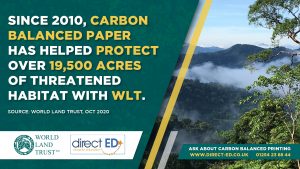
Direct-ED Becomes Carbon Balanced Printer
In January 2022, Direct-ED was officially confirmed as a Carbon Balanced Printer with the World Land Trust. This is amazing news that the team have




Today, schools have become a lot more complex and diverse in their methods of education, transitioning to become a hub of life skills and wider learning about the world around them. In the 21st century, school is somewhere children are given the opportunity to learn about being part of a community, communicating messages and taking action to help drive positive change – with sustainability at the heart of so many educational projects across the UK and beyond.
Sustainability for Schools is not a single path of action, and it is not something which is dictated exactly in the curriculum or in wider learning projects. For many schools, sustainability projects are something that they can take on and explore both inside and outside the classroom – designing new ways of becoming an eco-school with the ideas and support of the whole school community.
In this article we will be exploring what it means to be a sustainable school and sharing some of the ideas for sustainability projects that you can trial in your school.
What is a Sustainable School?
Sustainability is not just about planting trees and cutting down your use of paper. It is about how you integrate the environment and the natural world into every touchpoint of your school and the learning experience you provide to pupils. Climate Change and changes to our natural world are at the forefront of many of the causes that young people today are especially interested in, and school is a great place for us to educate these young people on the impacts of development and modernisation, and what they can do both on a small individual scale and on a wider scale to help.
A sustainable school is also one which extends its involvement beyond the reach of the playground and the school gates, by enabling them to get involved in the local community and by joining pupils together with local residents to make positive change to the area.
The Department for Children, Schools and Families outlines sustainability in schools under three core movements:
These three movements suggest to schools different ways that they can instil a sense of belonging and respect for the environment in pupils – from helping them understand the waste and energy produced by their school alone, to integrating environmental learning into the curriculum, and drawing inspiration from wider national sustainability projects.
Here are some of the best ways to inject sustainability projects into your school.
Sustainability Projects: A Guide
Get Outside
This doesn’t just mean getting out and about for playtime – it also means factoring the great outdoors into the learning day and school hours. Some of the most impactful projects for sustainability are those which get children involved in production, growing, and caring for plants and wildlife – and luckily, these include a wide range of fun and interactive activities. Some of our favourites include:
Cutting Waste
This is a big one in schools, as so many of our resources are considered wasteful. While there will always be a place for workbooks and paper products and these are so important to independent learning, looking for ways to bring tablets, digital support and more conversation into the classroom is a good way of expressing the need to be aware of the waste we produce on a daily basis and how we can cut it to save trees and natural resources.
Food and Drink
Food and drink is another touchpoint that schools can consider as part of a wide sustainability project, making efforts to drive pupils towards eating more healthily while in school. Packed lunched are notoriously difficult to monitor due to the fact that many parents take it upon themselves to provide food for their children during the day – this is why education across the full school community is so important, encouraging both pupils and their parents to explore healthier and more sustainable options. This can also include:
Engage in the Local Community
This is the method through which school express their sustainable commitments outside of the school gates, focussing on diversity and inclusivity throughout the local community. Schools have long immersed themselves in activities with and around locals, and these kinds of projects are great for giving children a high level of respect for human rights, freedoms, cultures, and self-expression.
Host school events and invite the local community, trust children to go out and interact with local residents (under supervision) and encourage residents to join in with sustainability goals and milestones.
Consider Modes of Transport
Last but not least, educate pupils about pollution and create interactive challenges and activities where children are encouraged to walk to school with their parents, cycle, or use public transport to reduce cars on the road.
The Takeaway
The creation and retention of a more sustainable world lies with the pupils and young people of today, and it is our job as educators to encourage them to express themselves and discover new and better ways of living more sustainable lives. All of the above ideas for projects are things that schools can easily and safely introduce as part of a wider curriculum, making sustainability fun and engaging for all ages.


In January 2022, Direct-ED was officially confirmed as a Carbon Balanced Printer with the World Land Trust. This is amazing news that the team have

If you’re wondering how to home school and are looking for some tips, the first thing to understand is that home learning isn’t just about

Sustainability is the buzzword of the 21st century and seems to have snuck into everything from fashion lines to supermarkets, our favourite television shows and




